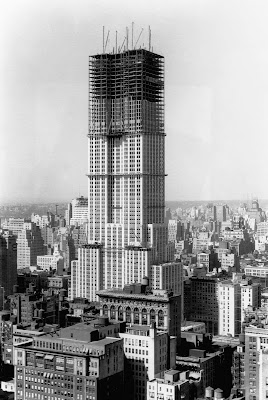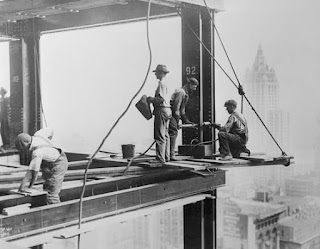In 2022, the Empire State Building in New York City became the #1 attraction for US travelers, and #3 attraction in the world overall, according to the coveted Travelers Choice® Awards. It is perhaps the world's most famous building.
The building's iconic Art Deco architecture, in addition to its height, is immediately recognizable in the skyline of New York City, but since the building's history is lesser known, we will delve into that history here.
BACKSTORY
In 1928, the location were the Empire State Building now stands on Fifth Avenue was occupied by the original Waldorf Astoria Hotel, a carry-over from New York City's late 19th Century "Gilded Age".
The Waldorf Astoria Hotel's original building from 1893 was demolished in 1929 to make way for the Empire State Building following the sale of the property to Bethlehem Engineering Corporation for approximately $20-million in 1928 -- the equivalent of approximately $323-million in 2022.
In 1929, former General Motors executive John Jakob Raskob, along with NYC movers-and-shakers Coleman and Pierre S. du Pont, Louis G. Kaufman and Ellis P. Earle formed the underlying corporation, Empire State, Inc., and appointed Alfred E. Smith, former Governor of New York, as its Chief Executive Officer.
Designed by the architectural firm of Shreve, Lamb & Harmon Associates and with the building process under the direction of Starrett Bros. & Eken, the Empire State Building would be the first 100+ story building in the world. Its exterior and interior Art Deco architectural and design elements are generally associated with the 1920s at the height of that style's popularity.
Today, the Empire State Building stands at 1,454-feet tall, inclusive of its tower and its broadcasting antenna, and has been named one of the Seven Wonders of the Modern World by the American Society of Civil Engineers. It remained the world's tallest building in New York City until 1970 when its height was surpassed by the World Trade Center.
CONSTRUCTION
The construction of the Empire State Building was part of a competition in New York City with 40 Wall Street and the Chrysler Building for the “world’s tallest building” .
It surpassed both.
Excavation of the site began on January 22, 1930. Actual construction of what at that time was called "the world's most ambitious building project" commenced on St. Patrick's Day, March 17, 1930, during the height of the worse economic Depression in USA history.
Although the project put men back to work, those who laboured on the steel beams hundreds of feet above the City, were constantly at great risk to life and limb. The project involved 3,400 workers, mostly European immigrants, as well as hundreds of Mohawk iron workers. Despite an astonishing lack of safety regulations, only 5 workers died during construction.
The steel frame literally grew before the eyes of New Yorkers at the astonishing rate of 4-1/2 stories per week, ultimately "topping off" at 102-stories after a record-breaking 13 months and 15 days -- completed on April 11, 1931, almost 2 weeks ahead of schedule.
It was the talk of the town. When President Herbert Hoover pressed a button in Washington, D.C. on May 1, 1931 officially opening the building, the lights on the Empire State Building were turned on for the very first time.
WORLD-WIDE ATTENTION
Being the world's tallest building, the Empire State Building quickly became a well-known attraction for both locals and tourists from around the world who flocked to it, paying their hard-earned 10-cents just to peer through one of its telescopes at the sprawling New York City urban landscape below. During one 6-month period in 1931, the building collected more than $3,000 in nickles and dimes -- the equivalent of approximately $57,000 in 2022.
The film industry permanently immortalized the Empire State Building by making it the focal point of one of cinema's most famous films, "King Kong", which debuted on March 2, 1933. This film would become the first of many memorable and pivotal "roles" that the building would play in the movies, firmly establishing it as both an important location integral to a movie's story, as well as an enduring icon of pop culture.
PRACTICAL USES
Corporate Headquarters
By 1948, just 17 years after its celebrated opening, the Empire State Building had become one of the world's most profitable buildings, and one of the world's most recognizable and loved architectural structures.
It was the headquarters for several major USA and international corporations, and a number of nonprofit charitable organizations, with a combined total of approximately 15,000 people employed there walking through its 5th Avenue Lobby every day. Visitors used a separate entrance on West 34th Street solely accessible by elevator to the Observatories for almost 90 years, until 2018.
Among the residents of the Empire State Building over the years have been the YWCA of the USA, The King's College, The National Film Board of Canada, Federal Deposit of Insurance Company (FDIC), Linkedin, and various international airlines.
Radio and TV Broadcasting
Broadcasting began at the Empire State Building on December 22, 1931, when NBC and RCA began transmitting experimental television broadcasts from a small antenna erected atop the building's mast, with two separate transmitters for the visual and audio data. They leased the 85th floor and built a laboratory there.
In 1934, RCA entered into a cooperative venture to test an FM system from the building's antenna. This ultimately resulted in the installation of the world's first FM radio transmitter which commenced transmitting from the antenna in 1940. After some time, the 85th floor became home to RCA's New York television operations as well, initially as an experimental station. Commencing in 1941, the station evolved into a commercial station which eventual became WNBC Channel 4. NBC retained exclusive use of the top of the building until 1950 when the Federal Communications Commission (FCC) ordered the exclusive deal be terminated so that other television broadcasters and sister FM stations could broadcast from the a single dedicated broadcast tower that was completed in 1951. Other television broadcasters gradually joined RCA in the Empire State Building on the 81st through 83rd floors, resulting in six broadcasters agreeing to pay a combined $600,000 per year for the use of the antenna. A new 222-foot, 60-ton broadcast tower was completed in 1953.
ACCOLADES AND MILESTONES DURING THE FIRST 50 YEARS
The 1950s also saw the American Society of Civil Engineers select the Empire State Building as one of the seven greatest engineering achievements in America’s history, ranking it alongside the Hoover Dam and the Panama Canal.
In 1956, as a symbol of welcome and freedom to visitors, four large beacon lights are installed at the foot of the building's tower. These beacons, which could be seen across the city, were known as “The Freedom Lights".
In 1961, Lawrence A. Wien, Peter L. Malkin, and Harry B. Helmsley purchased the Empire State Building for $65-million (the equivalent of approximately $557-million today). The price, which did not include the land, was the highest ever paid for a single building anywhere up to that point in time.
In 1976, The Empire State Building Observatory received its 50 millionth visitor -- marking the beginning of its drawing millions of visitors from all over the world each year thereafter.
==============================================
Primary and Photographic Sources: Empire State Building Archives; historycollection.com
%202=23.jpg)




